Stress has become an unavoidable part of modern life. From endless to-do lists to the pressure of maintaining a work-life balance, many people feel overwhelmed daily.
Anxiety, burnout, and chronic fatigue have become alarmingly common, affecting both mental and physical health. While many turn to complex self-care routines, the reality is that more isn’t always better.
Minimalist wellness offers a refreshing alternative. Instead of adding more to an already packed lifestyle, it encourages stripping away the unnecessary, leaving only what truly serves well-being.
A clutter-free environment, simplified routines, and mindful habits can drastically reduce stress and improve overall well-being.
Research suggests that excessive clutter, both physical and mental, can lead to higher cortisol levels. This increase in cortisol makes it more difficult to relax.
In the following sections, we’ll explore the principles of minimalist wellness, practical wellness tools for stress reduction, and how adopting a minimalist approach can transform daily life for the better.
Understanding Minimalist Wellness: A Lifestyle Shift for Mental Health
Minimalist wellness is more than just a design aesthetic. It’s a mindset that prioritises simplicity, clarity, and well-being. At its core, it involves eliminating unnecessary stressors, whether they come from cluttered spaces, overwhelming schedules, or excessive commitments. Unlike traditional self-care, which often encourages adding more activities or products, minimalist wellness focuses on doing less but with greater intention.
The Mental Health Connection
A growing body of research highlights the impact of environment and lifestyle on mental well-being. Studies have shown that a cluttered home can contribute to anxiety, stress, and even depression.
On the other hand, a simplified space promotes relaxation, focus, and a greater sense of control. By reducing distractions and unnecessary decisions, minimalist wellness helps manage stress and improve emotional well-being.
The Role of Mindfulness
Minimalist wellness and mindfulness go hand in hand. By practising mindfulness and paying attention to the present moment without judgment, individuals can break free from the cycle of stress and overthinking.
Simple habits like deep breathing, slowing down daily routines and focusing on one task at a time help cultivate a sense of calm and clarity. When combined with a minimalist approach, mindfulness creates a balanced lifestyle that supports both mental and physical health.
Wellness Tools for Stress Reduction: What Works and Why
A minimalist approach to wellness doesn’t mean eliminating all tools, it means using only what truly adds value. The right wellness tools for stress reduction can make a significant impact without overwhelming your routine.
Here are some simple yet effective tools that support both physical and mental health while aligning with a minimalist lifestyle.

1. Digital Detox & Screen-Free Zones
Constant notifications, social media, and blue light exposure can elevate stress levels and disrupt sleep. Creating designated screen-free zones such as the bedroom or dining area can help improve sleep quality and mental clarity. Research from the National Institute of Mental Health suggests that reducing screen time, especially before bed, can lead to better sleep and reduced anxiety.
2. Minimalist Meditation & Breathing Techniques
Meditation doesn’t require expensive apps or elaborate rituals. Simple breathing exercises, such as the 4-7-8 technique, help lower cortisol levels and promote relaxation. Just a few minutes of deep breathing each day can have lasting benefits, helping manage stress and boost mood.
3. Essentialism in Nutrition
Food choices can become a source of stress when they involve too many options or processed ingredients. A minimalist approach to eating involves simplifying meals, focusing on whole, nutrient-dense foods while reducing decision fatigue. This not only supports physical health but also promotes emotional well-being.
4. Multi-Purpose Wellness Items
Quality over quantity is key. Instead of cluttering your space with multiple wellness gadgets, invest in versatile, high-quality tools. A single yoga mat, a well-designed ergonomic chair, or a high-quality essential oil diffuser can serve multiple purposes without creating excess clutter.
By integrating these simple yet powerful tools, managing stress becomes effortless. The next section will explore how minimalist design for wellness can transform your environment into a stress-free space.
The Role of Minimalist Design for Wellness: Creating a Stress-Free Environment
The spaces we live and work in have a profound impact on our well-being. Cluttered environments can lead to higher stress levels, reduced focus, and mental fatigue. A minimalist design for wellness creates a sense of calm, order, and clarity, helping to manage stress more effectively.
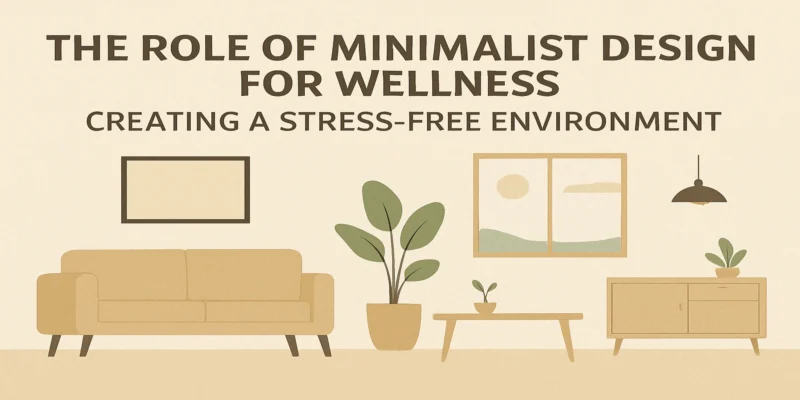
1. The Science of a Clutter-Free Space
Studies have shown that excessive clutter can increase cortisol levels, leading to feelings of overwhelm and anxiety. A well-organised, minimalist space encourages relaxation and improves mental well-being. By reducing unnecessary possessions, individuals create an environment that fosters peace and focus.
2. Optimising Home Layouts for Wellness
A minimalist approach to home design doesn’t mean living in a space. It’s about intentional organisation. Simple decluttering techniques, such as keeping surfaces clear, using storage efficiently, and maintaining open spaces, can transform any room into a stress-free zone.
Bedrooms should be designed for rest, workspaces should be distraction-free, and living areas should promote relaxation.
3. Incorporating Natural Elements
Nature has a grounding effect on mental health. Adding houseplants, maximising natural light, and using breathable fabrics like cotton and linen can enhance relaxation and improve indoor air quality.
The minimalist design embraces these elements, creating a home that feels calm, clean, and rejuvenating.
A well-designed space isn’t just about aesthetics, it directly impacts emotional well-being and stress management.
The next section will address common struggles people face when adopting minimalist wellness and how to overcome them.
Breaking Barriers: Common Struggles in Adopting Minimalist Wellness & How to Overcome Them
While minimalist wellness offers a path to reduced stress and improved well-being, many people struggle with the transition. From the fear of “letting go” to maintaining consistency, adopting this lifestyle can feel challenging. However, with the right approach, these barriers can be overcome.
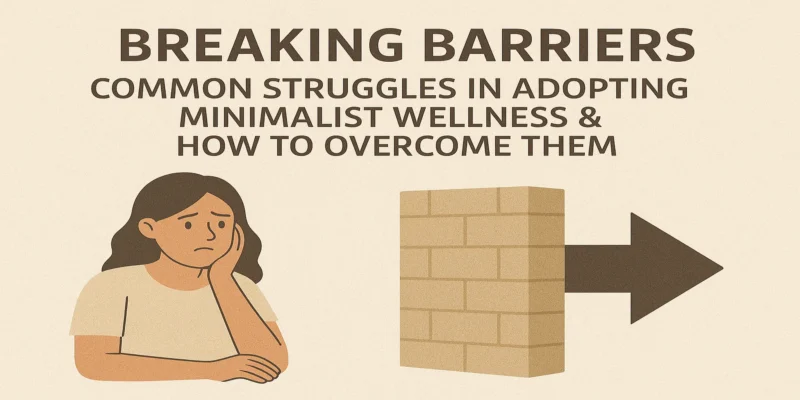
1. Overwhelm in Decluttering
A common misconception is that minimalism requires getting rid of everything at once. This can feel overwhelming, leading to hesitation or frustration. Instead, start small. Declutter one area at a time, such as a single drawer or digital files. Gradual progress makes the process manageable and sustainable.
2. Sustaining Minimalist Habits
Many people begin with enthusiasm but struggle to maintain minimalism for a long time. The key is to set simple, realistic habits. Regularly reassessing possessions, avoiding impulse purchases, and committing to mindful consumption help sustain a minimalist lifestyle without feeling deprived.
3. Balancing Minimalism with Daily Life
Minimalist wellness doesn’t mean living with the bare minimum. It’s about curating what genuinely adds value to your daily routine. Whether you have a family, a demanding job, or an active social life, balance is key. Focus on integrating minimalism where it feels natural, whether it’s simplifying meal prep, creating a calming morning routine, or limiting digital distractions.
By recognising these challenges and adopting a flexible approach, transitioning to minimalist wellness becomes easier. The next section will explore when professional guidance may be necessary and how to integrate it into a minimalist lifestyle.
When to Seek Professional Help: The Minimalist Approach to Mental Health Support
While minimalist wellness can significantly reduce stress, there are times when professional support is necessary. Mental health challenges such as chronic anxiety, depression, and burnout may require guidance from a mental health professional. Seeking help doesn’t contradict minimalism, it aligns with it by focusing on essential, effective support rather than overwhelming self-help strategies.
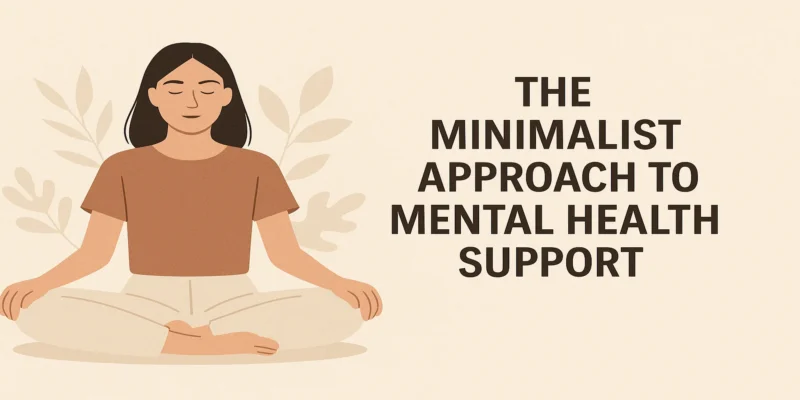
1. Recognising When Stress Becomes Unmanageable
It’s normal to feel stressed occasionally, but persistent feelings of anxiety, exhaustion, or emotional numbness could indicate deeper issues. According to the National Institute of Mental Health, chronic stress can lead to serious health problems, including heart disease and weakened immune function. If stress starts interfering with daily life, it may be time to seek professional guidance.
2. Minimalist Therapy Options
Minimalism doesn’t mean avoiding therapy; it means choosing practical, streamlined options. Online therapy platforms like BetterHelp provide accessible, no-fuss counselling that fits a minimalist lifestyle. Solutions such as guided self-help, mindfulness-based cognitive therapy, and short-term counselling offer effective support without unnecessary complexity.
3. How a Mental Health Professional Can Support Your Journey
A therapist or coach can help identify stress triggers and create personalised strategies for stress management. Rather than trying endless self-help methods, working with a professional ensures a focused, effective approach.
Whether it’s learning relaxation techniques, improving sleep quality, or developing emotional resilience, expert guidance simplifies the path to well-being.
Actionable Steps: How to Start Your Minimalist Wellness Journey Today
Embracing minimalist wellness doesn’t require a dramatic lifestyle overhaul. Small, intentional changes can lead to significant improvements in mental well-being and stress levels. Here is a simple five-step plan to help you get started.
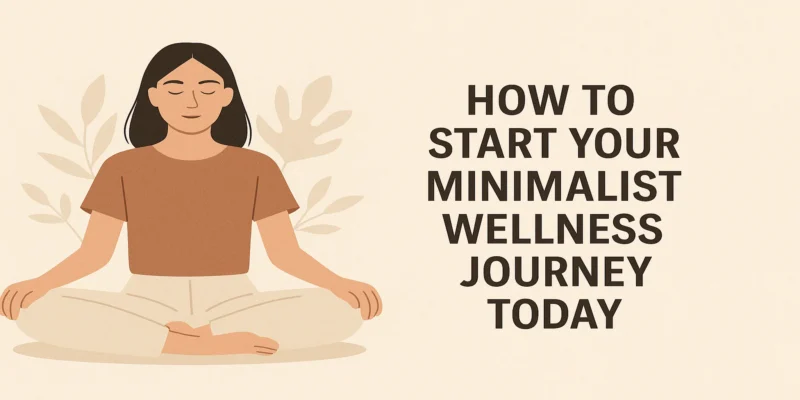
1. Identify Your Core Stressors
Take a moment to reflect on what’s causing stress in your life. Is it an overloaded schedule, cluttered space, digital distractions, or unhealthy habits? Identifying the main sources of stress allows you to make targeted changes rather than taking a scattered approach.
2. Declutter One Area at a Time
Minimalist wellness starts with simplification. Begin by decluttering one area, either your workspace, bedroom, or phone notifications. A tidy environment creates mental clarity and reduces anxiety. Research has shown that a clean, organised space leads to better focus and lower cortisol levels.
3. Simplify Your Wellness Routine
Rather than overwhelming yourself with multiple wellness practices, choose only the ones that truly benefit you. Whether it’s deep breathing, yoga, journaling, or daily walks, focus on quality over quantity.
4. Prioritise Mindfulness & Rest
Stress often comes from being constantly busy. Make space for stillness, whether it’s taking mindful breaks, spending time in nature, or setting boundaries with technology. Practising breathing exercises or limiting social media can significantly improve emotional well-being.
5. Evaluate & Adjust Regularly
Minimalist wellness is an ongoing process. Every few weeks, reassess what’s working and what’s not. Simplifying your routine, reassessing priorities, and making adjustments will help maintain long-term well-being without feeling overwhelmed.
By taking small, intentional steps, you can build a sustainable minimalist wellness practice that enhances both physical and mental health. The final section will highlight the lasting benefits of minimalist wellness and why it’s worth embracing.
Long-Term Benefits: Transforming Your Life Through Minimalist Wellness
Minimalist wellness isn’t just about reducing clutter, it’s about creating a life with more clarity, balance, and ease. By embracing simplicity, individuals can cultivate a lifestyle that promotes physical and mental health, reduces stress, and enhances overall well-being.
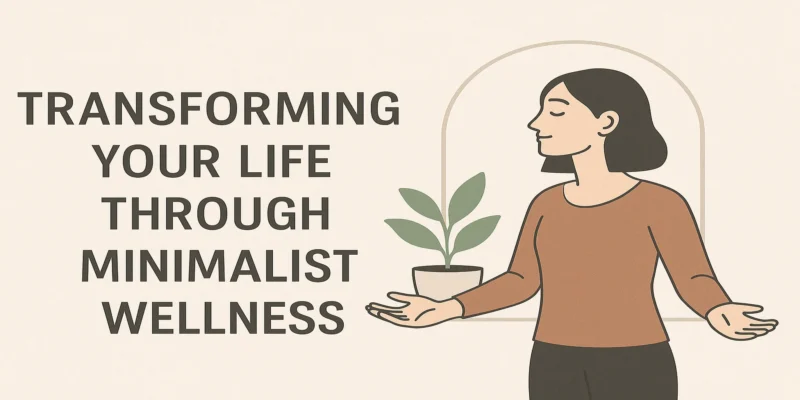
1. Sustainable Well-Being
Unlike quick-fix wellness trends, minimalist wellness focuses on long-term balance. With fewer distractions and unnecessary stressors, it becomes easier to maintain healthy habits, improve sleep quality, and prioritise self-care without feeling overwhelmed.
2. Personal Growth Through Simplicity
A simplified lifestyle encourages greater mindfulness, helping individuals focus on what truly matters. Whether it’s strengthening social connections, spending time in nature, or practising intentional relaxation, minimalism creates space for meaningful experiences.
3. Small Changes, Big Results
Minimalist wellness isn’t about perfection, it’s about progress. Even small shifts, like reducing digital distractions or decluttering a single space, can lead to noticeable improvements in mental well-being. The key is to start where you are and make changes at a comfortable pace.
Final Thought: Your Calm, Intentional Life Starts Here
Minimalist wellness offers a chance to slow down and focus on what truly matters. Clearing physical and mental clutter creates room for clarity, calm, and healthier routines that actually stick. With less noise and fewer distractions, it becomes easier to manage stress and feel grounded.
By adopting minimalist wellness, you can create a life that feels lighter, calmer, and more fulfilling. Ready to take the first step? Explore practical tools and resources at Made Minimal to simplify your wellness journey today.

